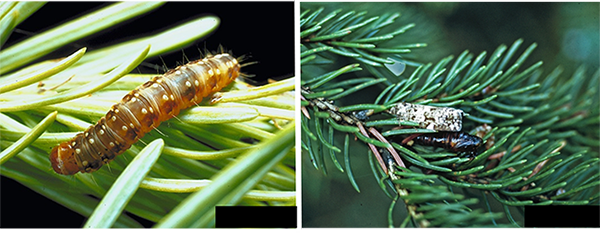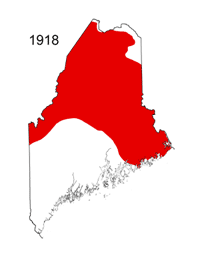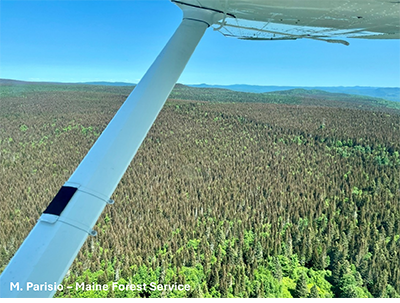DACF Home → Bureaus & Programs → Maine Forest Service → Forest Health & Monitoring → Forest Pest Index → Spruce Budworm in Maine
Spruce Budworm in Maine
- On this page:
Spruce budworm (Choristoneura fumiferana)
Spruce budworm (SBW) populations are increasing in Northern Maine. The Maine Forest Service (MFS) is a member of the Spruce Budworm Task Force (SBWTF) and with collective input based on the research conducted under the Healthy Forests Canada and others, the Spruce Budworm Task Force determined that the Early Intervention Strategies (EIS) shown to be successful in New Brunswick would be the best strategy for the protection and health of Maine’s forests.

General Information
Spruce budworm (SBW) is a native moth that defoliates balsam fir and spruce trees during the larval (caterpillar) phase. SBW is capable of widespread outbreaks that can cause extensive damage and mortality to spruce-fir forests after several years of feeding. SBW populations are normally present in Maine’s forests, but outbreaks can occur roughly every 40 years.
In Maine, the last SBW outbreak happened in the 1970s-1980s, where close to seven million acres of spruce and fir suffered severe damage and mortality. As a result, many trees that were dying from SBW damage were salvaged by clearcutting, a logging practice that involved cutting down most or all the trees in an area, which changed the forest landscape for the Pine Tree State for years. In addition to reduced natural resources and diminished water quality, local employment for those who rely on Maine’s forest-based economy was also impacted. Dead and dying trees provided fuel for wildfires to spread, which also reduced Maine’s air quality and resulted in drastic changes to wildlife habitat.
SPRUCE BUDWORM IN MAINE:
MODERATE OR GREATER DEFOLIATION
1918-1988

Spruce Budworm in 2025
In 2023, monitoring data suggested SBW populations were building toward an outbreak in northern Maine. When reports of visible damage began in 2024, MFS conducted an aerial survey and recorded roughly 3,400 acres of damage in northwestern Maine. During the winter, the University of Maine Spruce Budworm lab monitored SBW larvae (L2) on tree branch samples and found populations that were at or above the action threshold of an average seven larvae per branch in northern Maine. When larval populations are at or above the action threshold, an outbreak of SBW is likely to occur.

With the increase of SBW in these areas, timberland owners and managers in Maine formed the Maine Budworm Response Coalition (MBRC) and are working collaboratively with the MFS, Cooperative Forest Research Unit, and Maine Forest Products Council to reduce impacts from SBW as it builds toward outbreak conditions. The coalition successfully advocated for emergency funding to implement Early Intervention Strategy (EIS), a method developed and tested in New Brunswick, Canada to reduce SBW populations below the outbreak threshold. When SBW populations are reduced, natural enemies and other mortality factors can keep SBW populations from erupting. To be most effective, this strategy will need to be implemented at the landscape scale and across all ownerships before an outbreak occurs.
Aerial Spray Program 2025
The Maine Budworm Response Coalition (MBRC), comprised of timberland owners and managers in Maine, successfully advocated for emergency funding to oversee and implement the Early Intervention Strategy (EIS) methods to reduce the rising SBW populations and protect the health of our forest ecosystems and resources, maintain wildlife habitat, and prevent impacts to our forest-based economy. The MBRC collaborated with the Maine Forest Service (MFS), who provided technical assistance and communications with landowners and the public regarding biology, management options, and SBW history. Additionally, the MFS provided financial oversight and reimbursement for the state and federal funds supporting the SBW response.
MFS worked with landowners, scientists, the University of Maine, and other agencies to inform the MBRC where treatment was needed and how to best target those areas to reduce SBW populations below the outbreak threshold. To achieve this goal, the MBRC coordinated the administration of low-toxicity insecticides through an aerial spray program that concluded in early June 2025. Roughly 240,000 acres in northern Maine with larval populations at or exceeding the outbreak threshold were targeted. Additional details on the aerial treatments can be found on the Spruce Budworm Task Force page.
Insecticides containing active ingredients tebufenozide (Mimic) or Btk (Bacillus thuringiensis kurstaki, Foray) were applied by helicopter and/or fixed wing aircraft using modern technologies to ensure accurate applications. SBW populations may require additional aerial applications over the coming years to ensure the populations do not reach an outbreak level.
- FAQ: Tebufenozide (Mimic 2LV) (PDF)
- FAQ: Btk (Foray 76b) (PDF)
- Mimic 2LV Insecticide Label (PDF)
- Foray 76b Insecticide Label (PDF)
Eligible Acreage and Maximum Reimbursement for agreement holders under the Maine Spruce Budworm EIS Grant
Applicant Name |
Eligible Acreage |
Anticipated Cost |
Maximum Reimbursement |
| Blanchet Logging & Lumber | 9,569 | $ 430,605.00 | $ 387,544.50 |
| Clayton Lake Woodlands Holdings, LLC | 49,437 | $ 2,276,573.85 | $ 2,048,916.47 |
| Fallen Timber, LLC | 9,749 | $ 438,705.00 | $ 394,834.50 |
| Irving Woodlands LLC | 106,424 | $ 4,789,080.00 | $ 4,310,172.00 |
| Maine Bureau of Public Lands | 4,360 | $ 196,200.00 | $ 196,200.00 |
| Seven Islands Land Co | 44,125 | $ 1,985,625.00 | $ 1,787,062.50 |
| Solifor Timberlands INC | 18,129 | $ 815,805.00 | $ 734,224.50 |
| TOTAL | 241,793 | $10,932,593.85 | $9,858,954.47 |
The remaining federal funds are planned for use under a similar EIS treatment program in 2026. During the coming months, MFS will work with the Maine Budworm Response Coalition and others to refine and implement a plan to identify and offer treatment of building budworm populations. The State of Maine contributed $2 million in addition to the federal funding dollars, which will help to provide boots on the ground to support a small landowner program.
The Maine Forest Service is currently working with small landowners who are interested in having their woodlots considered for inclusion in the spruce budworm treatment program in 2026. Monitoring for SBW will be ongoing to provide insight on current populations so that landowners can make informed management decisions.
Monitoring Programs
A successful SBW monitoring program requires a multi-pronged approach and relies on the use of methods such as pheromone trapping, light trapping, overwintering larval (L2) sampling, and aerial and ground survey. Partnerships and observations from the community are key to a comprehensive monitoring program. MFS leads pheromone and light trapping and aerial and ground survey efforts. MFS supports the larval monitoring conducted by the University of Maine Spruce Budworm Lab.
- 2024 Pheromone Trap Map
- 2024 Ground Defoliation Survey
- Larval Populations (L2) Map
- Pheromone Trap Maps
- Annual Reports
Upcoming Events
None currently scheduled.